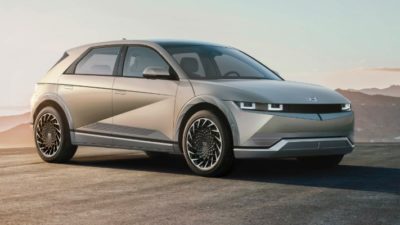Hyundai recently announced its latest electric vehicle known as the Ioniq 5 SUV to take on the likes of Ford Mach E, Tesla Model Y and other electric utility vehicles. However, in a sea of growing electric SUVs, how has Hyundai managed to make their EV stand out in the market? The short answer to that question is by focusing on the basics, and for the long answer, here’s everything you need to know about the Hyundai Ioniq 5 electric SUV.
Hyundai Ioniq 5: What A Looker!
First impression matters and Hyundai knows this. That’s why the Ioniq 5 electric SUV features a very tasteful modern-look. The Ioniq borrows design elements from Tesla Cybertruck and is sure to turn heads doesn’t matter if you’re using this car to pick up groceries on your way back from the office.
Like Tesla, the Ioniq also features pop-up door handles, which lends it a very aerodynamic look. From the inside, the Ioniq has a very minimal yet feature-rich interior. The dual displays at the front give out plenty of information to the driver. The seats are also very comfortable despite offering 30% less cushioning. And for the ultimate comfort, the seats in Ioniq reclines fully while offering a footrest to support your legs.
Additionally, most of the interior is either made from recycled plastic or is plant-based which means that Hyundai is doing its part in reducing its carbon footprint on the planet.
Speaking of footprint, the size of the Hyundai Ioniq 5 is quite large. It is bigger than the Volkswagen ID.4 electric SUV and longer than the Tesla Model 3 electric sedan.
Loaded To The Brim
Hyundai Ioniq is fully loaded in terms of features. To give you an example, the EV comes with a 240-volt electric plug for “Vehicle-to-Load” charging capabilities. Meaning you can charge any standard electric device using it. So it doesn’t matter if you’re in the middle of a secluded highway; if you feel like having a bread toast, you can very well power your toaster and enjoy your meal. You can use the port to charge your power tools, heaters or any other electronic even if the car is turned OFF. Now that’s bonkers!
In terms of connectivity, the Ioniq also comes with USB-type C ports and wireless charging mats, so no matter the device, the EV can keep them charged throughout the journey.
The feature list does not stop there because the windscreen in the Hyundai Ioniq can transform into a digital screen using AR technology. Useful as it may be, I still think it might be quiet a bit confusing to a lot of drivers.
Sure, people will get the feeling of playing a racing sim video game with this tech. However, it’d be in our best interest that people don’t take this feeling seriously or else a lot of people will end up searching for extra lives that don’t exist in reality.
Speaking of lives, the Ioniq comes with the most advanced driving assistant system to date. However, that isn’t saying much. We don’t yet know how it is compared to Ford Co-pilot, GM Cruise or Tesla Autopilot. But seeing Hyundai’s track record in battery technology, hydrogen vehicles and other areas, it’d no surprise if they ace in this segment as well.
To further increase the “utility” factor of Ioniq, it features 1600 litres of boot space with the rear seats folded down. Additionally, the passenger seats can shift forward to create more room for the cargo. The seats feature a 60:40 split which is just great.
Lastly, Hyundai Ioniq electric SUV comes with a solar panel. Another Hyundai car that features a solar panel roof is the Sonata Hybrid. The Korean manufacturer claims that the panels can charge Sonata Hybrid’s battery up to 60% with six hours of sunlight.
However, the Ioniq is a Battery Electric Vehicle, hence the efficiency of its solar panels is relatively higher. They can add up to 2000 km per year or 3 to 4 km per day of additional battery range. However, you’d have to live in a sunny place like Spain or Southern California to make use of it.
Goes Fast Lasts Longer
What good is an electric car with all its features if it cannot go any far? That won’t be a problem with the Hyundai Ioniq because it comes with a 480 km of battery range as per the WLTP cycle. It is less accurate than the EPA cycle used in America, but according to some real-world tests, the Hyundai Ioniq offers up to 5 km/kWh of efficiency.
Alright, since now we know that Hyundai can travel far. Let’s find out how quickly it can do so. The long-range AWD version of the Ioniq accelerates from 0 to 100 km/h in 5.2 seconds. The performance numbers are similar to a BMW 230i, a two-door convertible, which is pretty impressive for a compact SUV.
Let’s talk charging. Hyundai claims a 10 to 80% charge in just 18 minutes and 100 km of range in just 5 minutes. Hyundai can pull off these figures thanks to an 800 volt charging architecture along with 350 kW of charging rate.
To give you an idea of how impressive this is, Porsche Taycan, a much more expensive electric sports car, features 800-volt charging. Hyundai also managed to go one step further with an inbuilt adaptor, eliminating the need for additional equipment when using a 400-volt charger, as the 800 volt is the default charging state on Ioniq.
Hyundai has only released the pricing for the top-spec Ioniq model. In London, it costs around £48,000 without a government grant of £3,000. Will this car come to India anytime soon remains to be seen. However, with the push from government agencies and the automotive industry alike, EVs in India are about to become mainstream. The biggest EV manufacturer, Tesla, has already registered an office in Bengaluru, Tamil Nadu; therefore, EV enthusiasts won’t likely have to wait long.


























